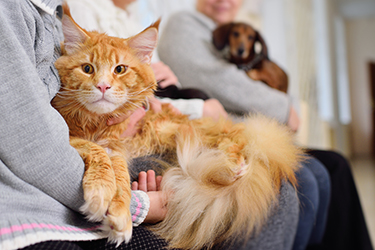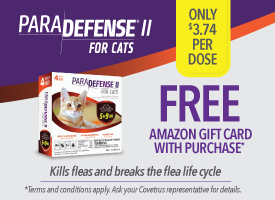COVID and cats: How the pandemic has affected feline patients and how to talk to your clients

by Leigh Hofmeister, DVM
Hardly any of us are unaffected by the COVID-19 pandemic. Businesses have had to modify how they operate with non-essential employees being furloughed and others being asked to work from home. Schools and universities have implemented virtual learning, confining all family members together under one roof. The uncertainty of what the future holds has created anxiety, and changes to the normal routine can stress every family member, pets included.
During this unique time of change and uncertainty, we cannot forget about our patients. While humans can process these changes and understand why this is happening, animals do not possess the same processing ability. Change is difficult for all animals to deal with and considering the rise in stress levels within a household, cats are without a doubt the most vulnerable. Cats are adverse to change, and for many cats, the walls of their home are their entire world. So, with humans suddenly invading their space, a housecat’s world really has been turned upside down.
Through this pandemic and time of stress, anxiety, and uncertainty we, as veterinary professionals, are in a unique position to help people. By utilizing the increase in communication through curbside service, suggesting certain changes in the home environment, and making the most out of a wellness visit, we can help families navigate these waters and even deepen the relationships with our clients.
Making the most of curbside
Curbside service was not something I was particularly excited to embark upon. Greeting families and their pets through the doors of the clinic where I work is one of the favorite things I enjoy most about my profession. I love seeing people, their children, talking to them about their pet, and really showing the physical exam, “Look at the tartar Mrs. Miller…see how Max is so slow to stand up and get going ...” I was nervous the communication and the value of the physical exam were going to be lost through a curbside approach. I love curbside service and most of my clients do, too. During appointments in the clinic, family members were often distracted by a cranky toddler or they were attempting to double task by bringing their pet for vaccines while on a conference call. Well, with curbside service, these distractions are much less. My clients are unable to use their phone for anything other than to talk to me about their pet. Another benefit to curbside is that I can sift through the medical record not only before I call the owner, but also while I am on the phone with them. Conversation flows easier this way, as previously I felt rude turning away from an owner in the exam room to look something up in their pet’s medical record. As I scroll through the medical record, I have gotten into the habit of taking a brief look to see if they have other pets. Maybe their cats haven’t been to the clinic in a few years. It is a good idea to work these other pets into conversation. Sometimes there is no record of any other pet, but I will still ask the owners if there are any other pets in the home. Often I find out that they lost their job and moved in with their parents who have a cat, or a significant other has moved into their home bringing a cat along or they just adopted a kitten and meant to ask when the kitten needs to come to the vet.
In addition to asking about the other pets in the household, I try to have a conversation about COVID-19. Making light of the situation we are all in and asking how everyone (pets included) is doing. Connecting with people helps deepen your bond with that client as we are all navigating these times together. How are you doing? Are you back at work now or are you working from home for the foreseeable future? How are the kids? Are they back in school or will they be continuing virtual learning? I know you are here with Max, but talk to me about Snowflake, I know she isn’t used to having all of you around so much. Do you notice any changes with her behavior? Most people appreciate being asked how they are doing, and how they perceive their pet is handling everything. But most people do not enjoy the stress their cat is likely experiencing. Even when a person tells me everyone is fine, I like to remind them this pandemic, with more family members home all day, is likely very stressful for cats. And even if they are not stressed, it is still a change. Cats do not handle change well, so giving owners ideas of how to create a home where their feline feels comfortable with the change is very helpful.
Make suggestions for keeping stress low at home
As I previously mentioned, cats do not handle change well. And while some cats may really enjoy having everyone home, many do not. Even if a cat is thriving with the increased attention and noise and uprooted routine, it is likely that at some point life will go back to the previous routine of the cat being home alone all day, and we should encourage our clients to think through these scenarios. While a lot of families allow their cats to experience the outdoors, many do not. So, for the average indoor housecat, that home is their entire world. Think about that! It makes sense having an increase in human presence day in and day out would cause a bit of anxiety for that cat.
The first thing to talk with clients about is routine. It is important for all pets to maintain a consistent routine. Cats thrive with a predictable day. It keeps their stress levels low. When a cat’s normal routine is disrupted, their sense of predictability and control is lost. Start by educating clients about keeping mealtime at roughly the same times each day. Maybe pre-pandemic the cat was being fed at 5am because the owner had to leave for work early in the morning and now isn’t fed until 8am because that person was furloughed, or their work day doesn’t begin as early as it did when they worked outside the home. Food is an important resource for all animals, it should never be an unpredictable part of a cat’s day.
Another part of a consistent routine should be rest. Every cat should have a place they can go and know they will not be bothered. For many cats it is their cat tree or a bed, a favorite pillow or dining room chair. Wherever that place is, family members should all agree that when the cat retreats, everyone ignores the cat. It will also help lower stress and anxiety in the housecats if the people in the family leave the home for several hours each day. This gives the cat time to recharge and allows for an easier transition when life does return to normal.
While more people in the family may be home more than usual, if a cat lives with a dog, that dog may be around more than usual. Some dogs have been away from the home more because owners have more time (or there are more family members) to take them hiking, running, swimming, walking, etc. But some dogs are home more because they normally go to daycare or agility classes which have been closed due to COVID. Talk with owners about encouraging a consistent routine with all pets in the household and help make people aware of how this pandemic has affected their pets. The routine should be similar to how life was like pre-COVID so that in the event life does return to normal, the transition will be somewhat seamless for all the pets in the family.
Make the most of the well visit
Perhaps all of the felines in your practice are seen every six months for their well visits, but if you are like many of the other practitioners around the country, you struggle to get your feline patients through the doors of your clinic. Whenever a cat comes in, even if not for vaccinations, we should all see that as a fabulous educational opportunity. While I would love to see cats every six months, I’m thrilled if people remember to bring them once year. And I fear with the pandemic, this could make feline veterinary visits decline even more.
However, with the stress and anxiety across the board, many families are keeping up with their cat’s veterinary care more than before because they are worried about their pet and want to make sure they are healthy! During these visits, take time to educate families on parasite prevention, vaccines their cat needs, healthy diets and vitamins that are beneficial. Remember, they are sitting in their car, fairly distraction free, listening to every word you say. If cats are struggling with underlying health issues, it will only worsen the stress the pandemic has caused them. If there are dogs in the house going out and about, but the cat is not on flea and tick prevention, this is a conversation we need to be having. Really take the time to consider the activity and exposure of other pets (and people) in the household and what they are bringing home to the housecat.
The effects of the COVID-19 pandemic are endless. People are worried about their jobs, their health, and their pets! As veterinarians, we are given an opportunity to reach out to our clients and ask how they are doing. Dive into the conversation, talk about COVID, acknowledge how hard it is for all of us: pets included. We are all experiencing this pandemic together, and I believe the veterinary-client-patient relationship is going to be even stronger when this ends.
Need Regulatory Assistance
If you need help with regulatory or licensing issues, we're happy to help. We have a wide variety of resources to help you when issues arise.

Careers
Are you looking for a place to let your talents shine? At Covetrus, we help our practitioner customers better serve their patients and take pride in providing the best customer experience possible. Search our open positions to see our available opportunities.
Newsletter
Stay current with what’s going on with Covetrus, subscribe to receive our newsletter and email communications. Subscribers will receive the latest information in practice management, sales and marketing, animal health, and more.



Leave a comment